|
| |
System: Activity Detection |
|
|
| Sensors |
The system consists of two sensors in the environment
(a microphone and a web camera) and a sensor in the computer (a computer
activity logger). The environment sensor data are integrated using a data
collection tool that Bilge Mutlu and Ian Li developed. The processed data
from the sensors are stored in log files.
The video input for the system is the Creative Ultra NX web camera. The camera
features a wide-angle lens making it sufficient to contain a large amount
of area of the office. Compared to other web cams, the quality of its images
are very good making it ideal as a sensor.
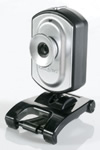 |
| Figure1. The Creative Ultra NX web
camera |
The input from the web camera is processed by the system to compute a motion
level value between 0 and 1 inclusively. Motion value is computed as the
normalized difference between the pixels of the current image and a previous
image.
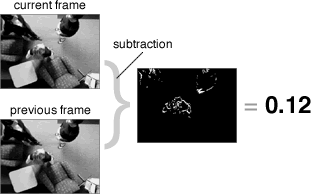 |
| Figure 2. Processing of the images
to produce a value for the motion level. |
A mini microphone is used to record the sound level in the environment. Sound
levels within intervals of a quarter of a second are averaged to give a final
value for sound level. Since sound level is the only feature recorded, the
participants' identities and topics of conversation are kept private.
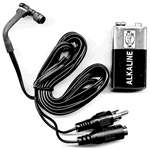 |
| Figure 3. The mini microphone |
The computer activity logger uses the AmIBusy toolkit that James Fogarty
developed. The toolkit provides classes to record computer input events such
as keystrokes, mouse clicks, and mouse movements. To protect users' privacy,
the program does not record what keys are pressed, only whether the keyboard
is being used. The logger records every one-tenth of a second whether there
was computer input.
 |
| Figure 4. The computer activity
logger |
|
|
|
| Data Collection |
The data from the environment sensors are integrated
together using a data collection tool that Bilge Mutlu and Ian Li developed.
The tool takes data from the sensors, processes them, and stores them in
a log file.
The collection tool has a user interface that allows a data collector to
log the actual state of the environment in real time. Since data was being
collected from different spaces at the same time for several hours, it is
not possible to have an observer to record the actual activities that are
happening in the space. To resolve this, the system takes snapshots of the
environment every 30 seconds. The snapshots are later labeled for activity.
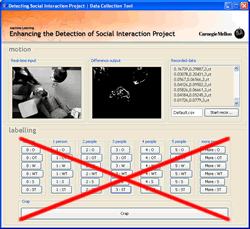 |
| Figure 5. The user interface for
the data collection tool that Bilge Mutlu and Ian Li developed. The
set of buttons is not used. |
|
|
|
| Deployment |
The system was deployed to four office environments: the
offices of two professors and two Ph.D. students. The participants agreed
to be recorded throughout the day from when they arrive in their office to
when they leave.
The sensors are installed in the participant's office space. The environment
sensors (web camera and microphone) are mounted on the ceiling in the middle
of the room to capture as much of the space. The computer activity logger
is installed in the participant's computer.
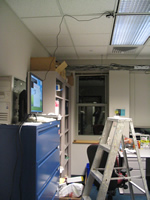 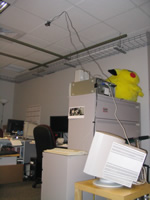 |
| Figure 6. The sensors deployed in
two participant offices. |
|
|
|
| Results |
I ran various machine learning algorithms (Bayes Net, Naive
Bayes, Logistic Regression, and Bagging with reduced-error pruning trees)
on the collected features from the environment sensors. I analyzed the sets
of features for each participant and day.
|
|
|
Recall
 |
| Participant |
Accuracy |
Classifier |
Outside |
Sitting |
Sit&Talk |
Walking |
 |
| Prof 1 Day 1 |
88.04% |
Bagging |
0.944 |
0.877 |
0.948 |
0 |
| Prof 1 Day 2 |
92.86% |
Bayes Net |
0.657 |
0.97 |
0.986 |
0 |
| Prof 2 Day 1 |
90.03% |
Bagging |
0.829 |
0.931 |
0.923 |
0.381 |
| Prof 2 Day 2 |
87.62% |
Bagging |
0.886 |
0.898 |
no data |
0.227 |
| Student 1 |
90.85% |
Bayes Net |
0.723 |
0.972 |
0.867 |
0 |
| Student 2 |
93.08% |
Bagging |
0.88 |
0.976 |
0 |
0 |
 |
| Table 1. The best detection
accuracies for each set of data (participant and day) |
The table shows that activities {outside, sitting, sitting
and talking, walking} can be accurately detected using features
from simple sensors (web camera and microphone). The detection accuracies
range from 88% to 93%. The best learning algorithms for detecting activities
were Bayes Net and Bagging with reduced-error pruning trees.
Notice that the recall of the activities, outside, sitting,
and sitting and talking, are very good. The amount of data collected
for these activities were sufficient to train the classifiers. On the other
hand, the detection of walking is very poor. Only a few algorithms were able
to detect walking, albeit those algorithms poorly detected walking.
The poor detection can be attributed to the small amount of training data
labeled walking. Another reason for the poor detection is that half
minutes sets of data were labeled. A walking activity only takes a few seconds
and thus the limitations of labeling the data hid the features of walking.
Notice that the accuracy of detection is fairly consistent across the different
participants. It might be possible that it is sufficient to train the classifier
for a day and to accurately detect activity for two days or a week. It also
might be possible that a classifier from a person can be generalized across
several people with no or minor modifications. |
|
|

